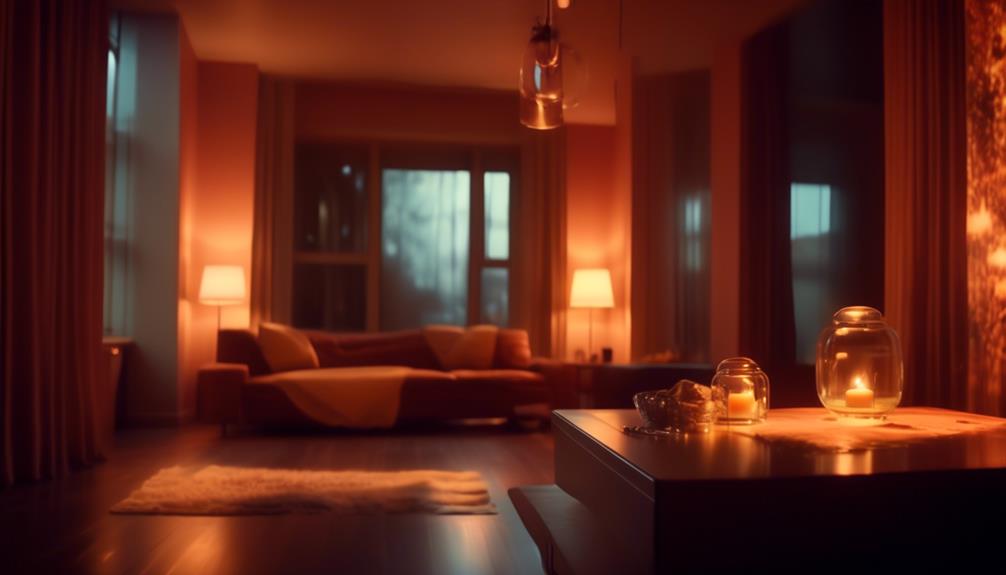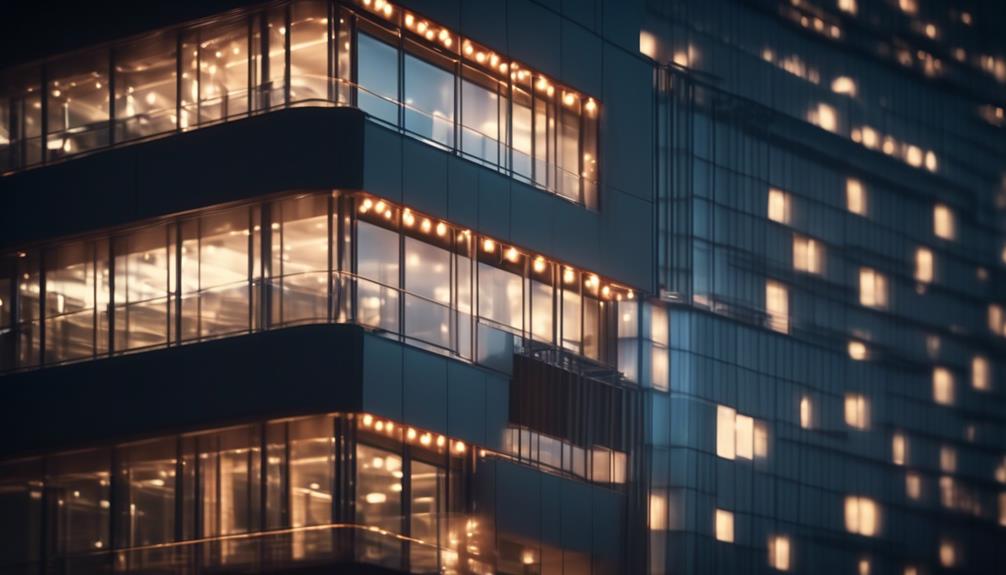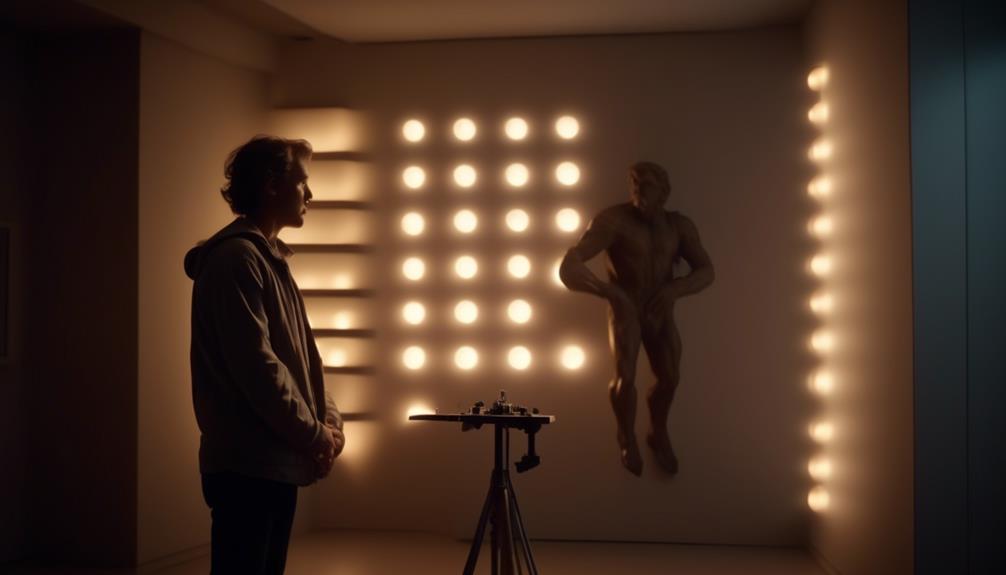Have you ever walked into a beautifully designed space and wondered how the lighting seemed to perfectly accentuate every element? The secret lies in the meticulous application of architectural lighting design principles.
From light distribution to energy efficiency, there are various factors that contribute to creating a visually stunning and functional environment.
In this discussion, we will explore the top architectural lighting design principles that are essential for creating captivating spaces.
So, if you're ready to unlock the secrets behind exceptional lighting design, get ready to discover the principles that will transform your spaces into works of art.
Key Takeaways
- Evenly distributing light throughout a space is important for creating a balanced and visually pleasing environment.
- The color temperature of lighting can significantly impact the ambiance and mood of a space, with warm lighting creating a cozy atmosphere and cool lighting providing a bright and energizing glow.
- Maximizing energy efficiency in lighting design involves incorporating daylight harvesting, using energy-efficient fixtures, and implementing smart lighting controls.
- Advanced lighting control systems allow for precise control over light intensity and color, integration of sensors and timers, and centralized control and monitoring of lighting fixtures.
Light Distribution

Light distribution plays a crucial role in architectural lighting design, ensuring that light is evenly and appropriately distributed throughout a space to achieve the desired aesthetic and functional effects. The intensity of lighting and its placement are key factors that need to be carefully considered.
When it comes to lighting intensity, it's important to strike the right balance. Too much intensity can create harsh and uncomfortable lighting conditions, while too little can result in a space that feels dull and uninviting. Achieving the right lighting intensity requires a thoughtful approach that takes into account the purpose of the space and the desired atmosphere.
In addition to intensity, lighting placement is equally important. The strategic placement of light fixtures can enhance the architectural features of a space, highlight specific areas, and create visual interest. By carefully considering the placement of lighting, architects and designers can guide the flow of movement within a space, create focal points, and emphasize important elements.
Color Temperature

To further enhance the overall lighting design, architects and designers must now consider the color temperature, a crucial element that influences the ambiance and mood of a space.
Color temperature is measured in Kelvin (K) and refers to the warmth or coolness of a light source. Warm lighting, with color temperatures below 4000K, creates a cozy and inviting atmosphere. This type of lighting is often used in residential spaces, restaurants, and lounges to evoke a sense of comfort and relaxation.
On the other hand, cool lighting, with color temperatures above 4000K, emits a bright and energizing glow. It's commonly used in retail stores, offices, and hospitals to promote productivity and alertness.
Energy Efficiency

Maximizing energy efficiency is a crucial aspect of architectural lighting design, ensuring optimal functionality and sustainability. By implementing energy-efficient strategies, you can reduce energy consumption and minimize environmental impact.
Here are five key principles to help you achieve energy efficiency in your lighting design:
- Daylight harvesting: Harness the power of natural daylight by incorporating daylight sensors and controls that adjust artificial lighting levels based on available natural light. This not only reduces energy usage but also creates a more pleasant and dynamic lighting environment.
- Sustainable lighting: Choose lighting fixtures and technologies that are energy-efficient and environmentally friendly. LED lights, for example, consume less energy and have a longer lifespan compared to traditional incandescent bulbs, making them a sustainable choice.
- Smart controls: Utilize smart lighting controls that allow for precise scheduling and dimming of lights. By adjusting lighting levels based on occupancy and time of day, you can significantly reduce energy consumption.
- Lighting zoning: Divide your space into different lighting zones and implement individual controls for each zone. This allows for tailored lighting levels and ensures that only the necessary areas are illuminated, further optimizing energy efficiency.
- Maintenance and monitoring: Regularly inspect and maintain your lighting system to ensure optimal performance. Additionally, monitor energy usage to identify any areas where efficiency can be improved.
Lighting Control

Harnessing the potential of advanced lighting control systems is essential in achieving optimal energy efficiency and sustainability in architectural lighting design.
Smart lighting technology has revolutionized the way we control and manage lighting in buildings, offering a wide range of benefits and possibilities.
With smart lighting systems, you can have precise control over the intensity and color of the light, allowing you to create the perfect ambience for any space.
These systems also have advanced dimming capabilities, allowing you to adjust the light levels according to the natural daylight available or the specific needs of the occupants.
By integrating sensors and timers, smart lighting technology can automatically adjust the lighting based on occupancy, ensuring that lights are only on when needed, thus saving energy and reducing costs.
Additionally, these systems can be easily integrated with other building management systems, allowing for centralized control and monitoring of all lighting fixtures.
With the flexibility and adaptability of smart lighting systems, you have the freedom to create dynamic and efficient lighting designs that enhance the functionality and aesthetics of any architectural space.
Safety and Maintenance

Ensuring the safety and proper maintenance of architectural lighting systems is crucial for optimal performance and longevity. By following safety standards and implementing preventative maintenance, you can keep your lighting systems operating at their best while minimizing the risk of accidents or failures.
Here are five important considerations for safety and maintenance:
- Regular inspections: Schedule routine inspections to identify any potential hazards or issues with the lighting system.
- Cleaning and dusting: Regularly clean and dust the lighting fixtures to maintain their efficiency and prevent overheating.
- Electrical connections: Ensure that all electrical connections are secure and free from any loose or damaged wires.
- Emergency lighting: Install emergency lighting to provide illumination during power outages or emergencies.
- Documentation and record-keeping: Maintain detailed records of all maintenance activities, including inspections, repairs, and replacements.
How Does Architectural Lighting Design Impact Circadian Rhythms?
Architectural lighting design influences circadian rhythms in various ways. Human centric lighting, when applied thoughtfully, can mimic the natural progression of light throughout the day, helping to regulate our internal body clocks. By considering the impact of artificial light on our circadian rhythms, designers can create more supportive and nurturing environments.
Conclusion
So there you have it, the top architectural lighting design principles.
By focusing on light distribution, color temperature, energy efficiency, lighting control, safety, and maintenance, architects can create spaces that aren't only visually appealing but also functional and sustainable.
These principles serve as the foundation for creating immersive and transformative lighting experiences that enhance the overall design and atmosphere of a space.
Now, armed with this knowledge, go forth and illuminate the world with your creative and technical prowess. The possibilities are endless.








